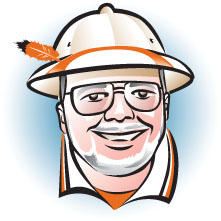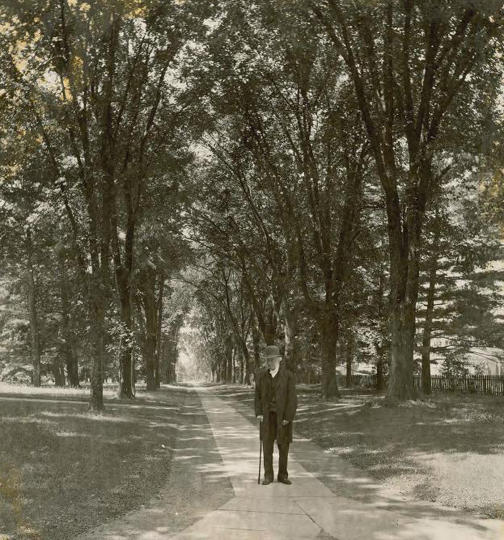Walks: The body advances, while the mind flutters around it like a bird.
– Jules Renard
The various recent environmental initiatives at Princeton, from the curriculum to the green construction of major projects like Butler College and the new Frick chemistry building , are very responsible and PC (yadayadayada) in themselves, but I have a sneaky suspicion that they also provide a convenient excuse to cater to a huge soft spot of long standing in the community: Tigers seem to love abounding florae and their accoutrements, and live for any flimsy excuse to enhance the natural beauty of the campus.
Example: “campus.” John Witherspoon got off the boat, looked around, and had to create a new word for the attractiveness of the front lawn of Nassau Hall (of course, that was compared to Scotland …).
Example: plantings. Even before Witherspoon, the trustees (between or during proper Presbyterian toasts at the Nass) planted two sycamore trees on Nassau Street to commemorate the 1766 repeal of the Stamp Act; they stand in front of Maclean House to this day, and are probably good for another 300 years or so.
Counterexample: “Tigers.” Only due to the chance influence of William of Orange (who never set foot in the Western hemisphere) did we escape going down in the athletic annals of the 20th century as the Princeton Fightin’ Squirrels. Right?
Example: cicadas. I’ve lost track of the number of my familiars who excitedly have gotten in touch about this year’s Brood II infestation in the Northeast. Never mind that it’s minor league vs. the mighty Brood X, which claimed dominance over commencements in 1953, 1970 (with a resulting Bob Dylan song ), 1987, and 2004, when environmentally responsible President Tilghman chose to focus on them in her message to the graduates, assuming they could hear her over the din of the bugs. Bonus points: They’re orange and black.
Example: Beatrix Farrand . One of the tiny group of lionized (tigerized?) women in Princeton’s male-only era (Isabella McCosh with her fixation on health care also comes to mind), Farrand made her Princeton debut exactly a century ago as the landscape designer (she would have said “gardener”) for the great new Graduate College, coincidentally the architectural beginning of übergothic Ralph Adams Cram on campus. In the immediate aftermath of the great Wilson/West fight over the College’s location, Cram and Farrand battled tooth and nail over the grounds. But she persevered for 30 years, and transformed the University with her fastidious and naturalistic plantings and designs. Her sensibility is felt to this day all over campus, for example in the willingness to watch where people walk, then build paths to match. Ta-DA!
Which brings us to McCosh Walk. The great Scots divine who emigrated to the United States precisely 100 years after John Witherspoon, by his retirement in 1888 McCosh (along with his wife Isabella, the health nut) was a walking legend. Literally. The first president to live in Prospect, he had created an aura that, even at 77 years of age, gathered his fan club every time he crossed the campus. In retirement, he moved to a home he had built nearby on Prospect Street; he would work in the morning, then about noon would walk across Washington Road, past Prospect and the Marquand Chapel to Nassau Street, rarely alone as seen above. By late 1889, the trustees bowed to the obvious and named the flagstone stretch from the Road to the Chapel McCosh’s Walk. Who suggested it? Unclear. As far as I can figure, there has never been even a plaque to note it (just modern-day street signs now and again). It was more of a living entity, part of the inherent order of things. Now stretching all the way to University Place, foliage-rich McCosh Walk acts as nature’s own thoroughfare through the old campus, as revered and remembered as its namesake.
And so we blithely skip a century (not to mention Ferrand’s tenure) to a campus that now stretches beyond Lake Carnegie and visually symbolizes “college” for a good portion of the nation. By 1998, Bob Goheen ’40 *48 had been retired for 26 years following 15 years as president transforming the entire institution, but not one item on the grounds carried his name. Harold Shapiro *64, president at the time and a huge Goheen fan, had a happy thought; the path through campus between the Old New and New New Quads from the Dinky to Palmer Stadium passed through a significant portion of Goheen’s legacy, and would be a fitting parallel to McCosh Walk. Given the more formalistic nature of modern times, the trustees commissioned a touching tablet for the new Goheen Walk, memorializing the dedication of both Goheen and his wonderful wife, Peg, and quoting in Greek the classicist’s beloved Sophocles. It was unveiled when Goheen was one year older than McCosh when his walk was named.
Three years later, when Shapiro in turn retired, the trustees grabbed a good thing when they saw it and named Shapiro Walk, the eastern extension of McCosh Walk from Washington Road, past Shapiro’s fellow social scientists and on to the E-Quad. It notes on its tablet inscription the honor both to Harold and to his wife Vivian, a big campus favorite who also was honored as the namesake of Café Vivian in the new Frist Campus Center. The Shapiro Walk stone also includes “In the Nation’s Service and the Service of all Nations,” the motto made possible by Goheen and then coined by Shapiro at the University’s 250th anniversary. And next to it is a bench in honor of Vivian, given by Harold and all their offspring.
Tempus fugit, as Goheen would say. As our current pioneering president from the hard sciences prepares to retire in July after 12 years, the trustees have chosen to forge a new path from Shirley Tilghman’s Lewis Center for the Arts below McCarter, past the new Edifice Regina, Whitman College, to the Icahn Laboratory that Tilghman inaugurated as the first head of the genomics institute. So in parallel with McCosh Walk, Shapiro Walk, and Goheen Walk, the campus now will boast the new Tilghman Walk, replete as per the now-established tradition with trees, plants, vistas, and memories worthy of Beatrix Farrand.
And from now on, for a very long time to come, all the good folks in the annual Reunions P-rade will conga down Elm Drive, then march (?) onto Poe Field through the snazzy arch built for that single purpose in the middle of Bloomberg Hall. And they’ll be marching on Tilghman Walk. A most natural and very Princetonian hail and farewell, indeed.















No responses yet